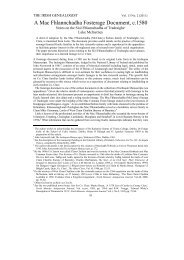Report Cover Vol I - Clare County Library
Report Cover Vol I - Clare County Library
Report Cover Vol I - Clare County Library
You also want an ePaper? Increase the reach of your titles
YUMPU automatically turns print PDFs into web optimized ePapers that Google loves.
The <strong>County</strong> <strong>Clare</strong> Wetlands Survey Patrick Crushell & Peter Foss 2008<br />
_______________________________________________________________<br />
This category includes lakes and ponds that are low in nutrients, base-poor and acidic; those that are<br />
oligotrophic and base-rich should be considered under limestone/marl lakes - FL3. Most acid oligotrophic<br />
lakes are associated with areas of acidic bedrock and many have rocky margins. The substratum in<br />
shallow water is either rock, organic lake sediment, or coarse mineral material (sand and gravel). Water<br />
is often brownish in colour as a result of inputs from peaty soils or bogs in the catchments. These lakes<br />
support communities of submerged and floating aquatic plants. Small submerged aquatics such as<br />
Shoreweed (Littorella uniflora), Water Lobelia (Lobelia dortmanna) and Bulbous Rush (Juncus bulbosus)<br />
occur in shallow water. Quillworts (Isoetes spp.) may be abundant but are rarely visible as they colonise<br />
lake sediments in deep water. Floating aquatics include Bog Pondweed (Potamogeton polygonifolius),<br />
Alternate Water-milfoil (Myriophyllum alterniflorum) and Floating Club-rush (Eleogiton fluitans). Fringing<br />
emergent vegetation may include open stands of Common Reed (Phragmites australis); if extensive, reed<br />
beds should be considered under reed and large sedge swamps - FS1.<br />
Links with Annex I: Acid oligotrophic lakes correspond to two annexed habitats, 'oligotrophic waters<br />
containing very few minerals of sandy plains (Littorelletalia uniflorae) (3110)' and 'oligotrophic to<br />
mesotrophic standing waters with vegetation of the Littorelletea uniflorae and/or of the Isoto-<br />
Nanojuncetea (3130)'.<br />
FL3 Limestone/marl lakes<br />
This category includes lakes and ponds of limestone areas (other than turloughs - FL6) that are baserich<br />
and poor to moderately rich in nutrients (oligotrophic to mesotrophic). The water is typically clear<br />
and the lake sediment usually has a high proportion of marl, a white clayey precipitate of calcium<br />
carbonate. Marl-forming stoneworts (Chara spp.) are often abundant and may form dense carpets in<br />
unpolluted waters. Various-leaved Pondweed (Potamogeton gramineus) is also characteristic. These lakes<br />
are frequently fringed by rich fen and flush - PF1 vegetation.<br />
Links with Annex I: Corresponds to the annexed habitat, 'hard oligo-mesotrophic waters with benthic<br />
vegetation of Chara spp. (3140)'.<br />
FL4 Mesotrophic lakes<br />
This category includes lakes and ponds that are moderately rich in nutrients, and where the water is<br />
sometimes discoloured by algae. Characteristic aquatic plants include White Water-lily (Nymphaea alba),<br />
Yellow Water-lily (Nuphar lutea), and a large number of pondweeds (Potamogeton gramineus, P.<br />
obtusifolius, P. perfoliatus). Stoneworts (Chara spp.) may also be present. The fringing and aquatic plant<br />
communities are typically more lush than those associated with oligotrophic lakes.<br />
FL5 Eutrophic lakes<br />
This category includes lakes and ponds that are high in nutrients and base-rich and where the water is<br />
usually discoloured or turbid, often grey to green in colour, from the abundant algae and suspended<br />
matter. Some water bodies are naturally eutrophic but most Irish lakes are eutrophic as a result of<br />
enrichment and high levels of nutrients entering the water. This category can also include hypertrophic or<br />
highly-enriched (polluted) waters. Characteristic aquatic plants of eutrophic lakes and ponds include<br />
duckweeds (Lemna spp.), pondweeds (Potamogeton pectinatus, P. crispus) and Spiked Water-milfoil<br />
(Myriophyllum spicatum). Submerged aquatics are usually rare or are restricted to shallow waters owing<br />
to poor light penetration. Reed beds on sheltered shores and dense stands of fringing vegetation are<br />
characteristic of eutrophic lakes and ponds; if reed beds are extensive they should be considered under<br />
reed and large sedge swamps - FS1.<br />
Links with Annex I: Only those lakes that are naturally eutrophic are recognised as the annexed habitat,<br />
'natural eutrophic lakes with Magnopotamion or Hydrocharition-type vegetation (3150)'.<br />
FL6 Turloughs<br />
Turloughs are ephemeral lakes that occupy basins or depressions in limestone areas, and where water<br />
levels fluctuate markedly during the year. They are virtually unique to Ireland and their greatest<br />
concentration is in counties <strong>Clare</strong>, Galway and Roscommon. The general pattern is to flood in winter and<br />
dry out in summer, but there may be other sporadic rises in response to high rainfall. Turloughs normally<br />
fill through underground passages and sinkholes but some also have inflowing rivers or streams. Some<br />
turlough basins retain standing water in channels, pools or small lakes when flooding subsides. All areas<br />
within the normal limit of flooding are considered as part of the turlough habitat. The presence of the<br />
distinctive dark moss, Cinclidotus fontinaloides, on stone walls or rocks can help to establish this level.<br />
105
















